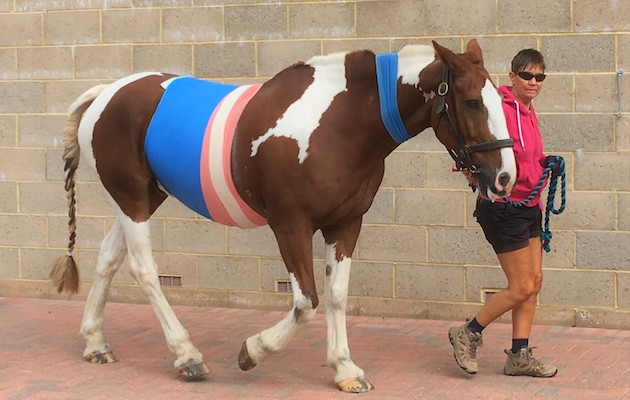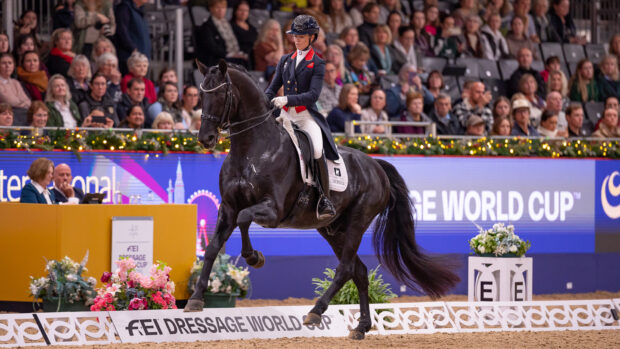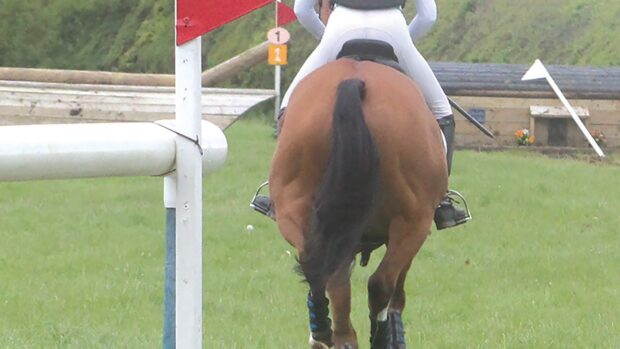
Bertie with the Sussex Equine Hospital team after his surgery
The owner of a horse who underwent surgery to remove a 15kg mass of impacted food from his stomach wants other owners to be aware of the condition.
Debbie Scott-Downes’ Irish sport horse Matchmaker was being scoped when vets realised the mass — three-quarters of the weight of a standard bag of feed — was taking up a large proportion of his stomach.
Debbie told H&H “Bertie” first seemed off-colour a year ago but that after a month’s holiday, he seemed better and the pair started competing, registering with British Dressage last winter.
“We qualified for the regionals in three outings and we were working hard – then he went really dull to ride,” Debbie said.
“I thought he needed another holiday but kept thinking ‘there’s something wrong with this horse’, I just couldn’t put my finger on what it was.
“Then he had two little rumbling colics, with no impaction symptoms, had some time off, then came back into work and he just had no oomph.”
Debbie was referred by Fernando, one of Sussex Equine’s ambulatory vets, to have a medicine work-up including being scoped for ulcers at Sussex Equine Hospital.
“They found this solid mass, that looked like the surface of the moon, taking up most of his stomach and stretching it,” she said. “But it’s so rare, I couldn’t find anything about it online.”
Treatment involved continual tubing and siphoning water to try to soften the mass of old, impacted food.
“By last Tuesday, the treatment had gone on for a week and I felt I couldn’t put him through that any longer,” Debbie said. “We thought we were going to have to put him down.”
But after Debbie spoke to surgeon Luis Martinez at the hospital, Bertie went in for his surgery on 5 September. During the six-and-a-half hour procedure, which included recovery from the general anaesthesia, vets removed the 15kg mass. Bertie stayed in the hospital for a week but is now recovering at home.
He faces a long road of box rest, sloppy feed and controlled exercise but his prognosis is good at this stage, and Debbie, who was “camping out” at the hospital, was glad to get him back in his stable.
“He’ll be in a chifney as he’s feeling well!” Debbie said. “I don’t know how the poor boy was so willing to work and try for me, with all that in there.
“It’s a relief to know what it was. I couldn’t explain it to anyone but I just knew there was something wrong, and I would hate it if anyone else was in this position, of not being able to find out anything about it.”

Sussex Equine Hospital veterinary associate Natasha Jocelyn said gastric impaction is a recognised condition but that Bertie’s was “very big and severe”.
“When we first scoped him, we wondered if he’d managed to eat eat his bedding while being fasted for the gastroscopy as his stomach was full,” she told H&H. “But when we re-scoped, we could clearly see the impaction, although it’s really hard to determine size.”
Natasha added that routine treatment is as described above but that as there was no improvement in Bertie’s condition after a week, the team discussed the next steps.
“Surgery is rare and the prognosis is very poor but for him, there was little other option,” she said.
“It was like colic surgery; a big mid-line incision. The stomach is hard to access but the team here did an amazing job; three surgeons were working as a team to achieve it.”
Natasha said the big risk was contamination of the abdomen with the food matter, but strategic use of lavaging and sterile plastic bags helped combat this, while the vets had to lift the food matter out by hand.

“It was a huge amount,” she said. “Quite a sight! We’ve got some great surgeons here.”
Bertie was lavaged again, stitched up and given antibiotics, and a scope showed the incision seemed to be healing well.
“He’s doing amazingly well so far,” Natasha said on Tuesday (18 September). “Everyone was waiting with bated breath; there’s a risk under anaesthetic that the stomach might rupture, and with a big stomach pressing on the lungs it makes anaesthetising riskier but the whole team worked together to achieve this outcome for Bertie.”
Continues below…

Tales from Windsor: miraculous show horse bounces back after losing an eye
Meet the miraculous coloured show horse who has recovered from eye surgery and a life-threatening infection

Zebra successfully undergoes colic surgery in America
Vets in America have successfully performed colic surgery on a two-year-old Zebra called Dante who is now recovering at Washington

Colic surgery in horses: all you need to know
Colic surgery is a potentially serious operation that presents a significant challenge for all concerned
Bertie is now on treatment to improve the contraction of his stomach, as it is possible he may have an underlying issue in this area, but it is not known exactly why these gastric impactions form, and the matter is the subject of research elsewhere.
He will return to the clinic for another gastroscope a month after the surgery and be the subject of close monitoring with Debbie.
“He’s got a long road ahead but he’s doing amazingly well, better than all of us could have dreamed,” Natasha said.
For all the latest news analysis, competition reports, interviews, features and much more, don’t miss Horse & Hound magazine, on sale every Thursday.




